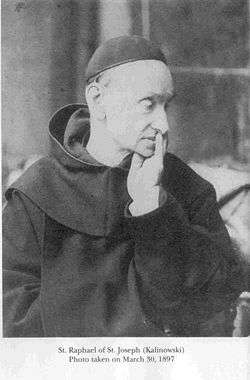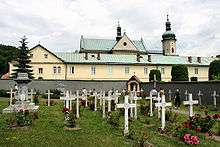Raphael Kalinowski
| St. Raphael of St. Joseph Kalinowski, O.C.D. | |
|---|---|
|
Photograph of Saint Rafał of St. Joseph taken on 30 March 1897 | |
| Born |
Józef Kalinowski 1 September 1835 Vilnius, Russian Empire |
| Died |
15 November 1907 (aged 72) Wadowice, Russian Empire |
| Venerated in | Roman Catholic Church |
| Beatified | 1983, Kraków, Poland, by Pope John Paul II |
| Canonized | 17 November 1991, St. Peter's Basilica, Vatican City by Pope John Paul II |
| Feast | 19 November |
Raphael of St. Joseph Kalinowski, O.C.D. (Polish: Józef Kalinowski, Lithuanian: Rapolas Kalinauskas) (1 September 1835 – 15 November 1907) was a Polish Discalced Carmelite friar inside the Russian partition of Polish-Lithuanian Commonwealth, in the city of Vilnius (Pl: Wilno; Ru: Вильнюс). He was a teacher, engineer, prisoner of war, royal tutor, and priest, who founded many Carmelite monasteries around Poland after their suppression by the Russians.
Kalinowski was canonized by Pope John Paul II in 1991, the first man to be so recognized in the Order of Discalced Carmelites since Saint John of the Cross.
Childhood

He was born Józef Kalinowski to a noble "szlachta" family in the city of Vilnius (Wilno). At the time he was born, the area was known as a Russian partition, though it had formerly been part of the Polish-Lithuanian Commonwealth. He was the second son of Andrew Kalinowski (1805–1878), an assistant superintendent professor of mathematics at the local Institute for Nobles (Instytut Szlachecki). His mother, Josephine Połońska, died a few months after he was born, leaving him and his older brother Victor without a mother. His father then married Josephine's sister (a practice that was not uncommon in that time), Sophie Połońska, and had three more children: Charles, Emily, and Gabriel. After Sophie died in 1845, Andrew married again, this time to the 17-year-old Sophie Puttkamer, daughter of Maryła Wereszczak (famous at the time for being written about by Adam Mickiewicz), who became mother to all of Andrew's existing children and had four more of her own: Mary, Alexander, Monica, and George.
From the age of 8, Kalinowski attended the Institute for Nobles at Vilna, and graduated with honors in 1850.[1] He next attended the School of Agriculture (Instytut Agronomiczny) at Hory-Horki, near Orsha.
Military career
The Russians strictly limited opportunities for further education, so in 1853 he enlisted in the Imperial Russian Army and entered the Nicholayev Engineering Academy (Mikołajewska Szkoła Inżynierii). The Army promoted him to Second Lieutenant in 1856. In 1857 he worked as an associate professor of mathematics, and from 1858-1860, he worked as an engineer who helped design the Odessa-Kiev-Kursk railway.
In 1862 the Imperial Russian Army promoted him to Captain and stationed him in Brest, Belarus, but he still sympathized with the Poles. He consequently resigned from the Imperial Russian Army in 1863 to serve as minister of war for the January Uprising, a Polish insurrection, in the Vilnius region. He determined never to sentence anyone to death nor to execute any prisoner. When the Poles rose against the Russians in 1863, Raphael joined them and was soon taken prisoner. Very few survived the forced march to slave labour in Siberia, but Raphael was sustained by his faith and became a spiritual leader to the prisoners. He was released ten years later.[2]
Siberia
On 24 March 1864, Russian authorities arrested Kalinowski and in June condemned him to death by firing squad. His family intervened, and the Russians, fearing that their Polish subjects would revere him as a political martyr, commuted the sentence to 10 years in katorga, the Siberian labor camp system. They forced him to trek overland to the salt mines of Usolye-Sibirskoye near Irkutsk, Siberia, a journey that took nine months.[1]
Three years after arriving in Usolye, Kalinowski moved to Irkutsk. In 1871/1872 he did meteorological research for the Siberian subdivision of the Russian Geographical Society. He also participated in research expedition of Benedykt Dybowski to Kultuk, on the shore of Lake Baikal. Authorities released him from Siberia in 1873 but exiled him from Lithuania; he then moved to Paris, France.
Royal tutor
Kalinowski returned to Warsaw in 1874, where he became a tutor to 16-year-old Prince August Czartoryski. The prince was diagnosed with tuberculosis in 1876, and Kalinowski accompanied him to various health destinations in France, Switzerland, Italy, and Poland.[1] Kalinowski was a major influence on the young man (known as "Gucio"), who later became a priest and was beatified by Pope John Paul II in 2004.
Later Kalinowski decided to travel to the city of Brest where he began a Sunday school at the fortress in Brest-Litovsk where he was a captain, he became increasingly aware of the state persecution of the church, and of his native Poles.
Carmelite friar and priest
In 1877 Kalinowski was admitted to the Carmelite priory in Linz, and where he was given the religious name of Brother Raphael of St. Joseph, O.C.D. The name "of St. Joseph" had nothing to do with his birthname—it was common for many Carmelites to list their name as "of St. Joseph", after the "Convent of St. Joseph" founded by Teresa of Avila, co-founder of the Discalced Carmelite Order.
Kalinowski was ordained as a priest at Czerna in 1882 by Bishop Albin Dunajewski, and in 1883 he became prior of the monastery at Czerna.
Kalinowski founded multiple Catholic organizations around Poland and Ukraine, most prominent of which was a monastery in Wadowice, Poland, where he was also prior. He founded a monasteries of Discalced Carmelite nuns in Przemyśl in 1884, and Lvov in 1888.
From 1892-1907 Kalinowski worked to document the life and work of Mother Theresa Marchocka, a 17th-century Discalced Carmelite nun, to assist with her beatification.
Kalinowski died in Wadowice of tuberculosis in 1907.[3] Fourteen years later, Karol Wojtyła, later known as Pope John Paul II, was born in the same town.
Kalinowski was a noted spiritual director of both Catholic and Russian Orthodox faithful.[4]
Veneration
Kalinowski's remains were originally kept in the monastery cemetery, but this proved unmanageable because of the large number of pilgrims who came visiting. So many of them took handfuls of dirt from the grave that the nuns had to keep replacing the earth and plants at the cemetery. His body was later moved to a tomb, but the pilgrims went there instead, often scratching with their hands at the plaster, just to have some relic to keep with them.[5] His remains were then moved to a chapel in Czerna, where they remain.[6]
Kalinowski was beatified by Pope John Paul II in 1983 in Kraków, in front of a crowd of over two million people. On 17 November 1991, he was canonized when, in St. Peter's Basilica, Pope John Paul II declared his boyhood hero a saint.[7] Rafał was the first friar to have been canonized in the Order of the Discalced Carmelites since co-founder Saint John of the Cross (1542–1591).
Kalinowski's feast day is celebrated on 19 November in the Discalced Carmelites order and 20 November by the catholic church in Poland.
Literary works
- Carmelite Chronicles of the monasteries and convents of Vilnius, Warsaw, Leopolis, and Kraków
- Translated into Polish the autobiography of St. Therese of Lisieux, The Story of a Soul
- Wrote biography of Hermann Cohen (a famous Jewish pianist, who had converted to the Carmelite Order and become "Father Augustine Mary of the Blessed Sacrament")
- Kalinowski, Rafal, Czesc Matki Bozej w Karmelu Polskim, in Ksiega Pamiatkowa Marianska, Lwów-Warszawa 1905, vol. 1, part II, pp 403–421
- Kalinowski, J. Wspomnienia 1805-1887 (Memoirs 1805-1887), ed. R. Bender, Lublin 1965
- Kalinowski, Jozef, Listy (Letters), ed. Czeslaus Gil, vol. I, Lublin 1978, vol II, Kraków 1986-1987
- Kalinowski, Rafal, Swietymi badzcie. Konferencje i teksty ascetyczne, ed. Czeslaus Gil, Kraków 1987
See also
- Ecumenism
- Eastern Christianity
- Byzantine Discalced Carmelites
- Carmelite Rule of St. Albert
- Book of the First Monks
- Constitutions of the Carmelite Order
- Jan Tyranowski
- List of Polish saints
Notes
- 1 2 3 Sokol, p. 173
- ↑ The Complete Illustrated Encyclopedia of Saints, Tessa Paul, Reverend Ronald Creighton Jobe, Anness Publishing, p.228
- ↑ Sokol, p. 174
- ↑ Carmelite.com > Our saints > St. Raphael Kalinowski at www.carmelite.com
- ↑ Elonka's Family: Pics and Info about Saint Raphael Kalinowski
- ↑ Witryna Krakowskiej Prowincji Karmelitów Bosych at www.karmel.pl
- ↑ The Vatican's 1991 press release about his canonization
References
- Biography by Eileen Ahern, OCDS
- Elonka's family: Pics and info about Saint Raphael - a biographical page by his great-great-grandniece, with references to several published biographies
- (Polish) Polish-language page about Saint Raphael with many pictures
- (Italian) Beatification of Father Raphael Kalinowski and Brother Albert Chmielowski in Krakow (June 22, 1983)
- Praskiewicz, Szczepan, Saint Raphael Kalinowski: an Introduction to His Life and Spirituality, 1998, ICS Publications, ISBN 0-935216-53-7
- Blessed Raphael Kalinowski of Saint Joseph, His Life in Pictures, 1983, Rome, Postulation General
- Gil, Czeslaus, OCD, Rafał Kalinowski
- Monk Matthew, Saint from the Salt Mines, 1986, Mid-Suffolk Printing Company, distributed by Carmelite Book Service, Oxford
- Sokol, Stanley (1992). The Polish Biographical Dictionary. United States: Bolchazy-Carducci Publishers. ISBN 0-86516-245-X.
- "Miracle Clears Way for Sainthood Cause." The Catholic Sun, July 19, 1990
External links
![]() Media related to Rafał Kalinowski at Wikimedia Commons
Media related to Rafał Kalinowski at Wikimedia Commons

